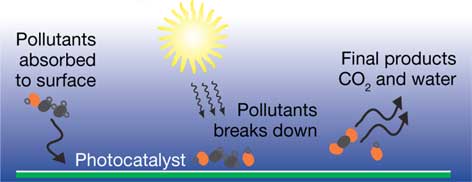|

Researchers
at The Chinese University of Hong Kong are further refining a sol-gel
derived nanosized coating solution which can keep buildings clean
and prevent seafood gourmets from contracting diseases like cholera.
 The
basis of their revolutionary NanoPCO™ cleaning technology is
a photocatalytic layer of nano-particles which can be applied to
buildings, or the filtration elements of water and air purifiers.
Under ultraviolet light, the layers induce photocatalytic activity
which can oxidise most known pollutants, and kill harmful bacteria
in water and air. The
basis of their revolutionary NanoPCO™ cleaning technology is
a photocatalytic layer of nano-particles which can be applied to
buildings, or the filtration elements of water and air purifiers.
Under ultraviolet light, the layers induce photocatalytic activity
which can oxidise most known pollutants, and kill harmful bacteria
in water and air.
 |
 Water
disinfecting systems based on the technology are already in use
in Hong Kong. Principal Investigator Prof Jimmy Yu and his team
are now working on making the process more efficient by altering
the sol-gel formula so that it reacts in an expanded portion of
the useable solar spectrum. Water
disinfecting systems based on the technology are already in use
in Hong Kong. Principal Investigator Prof Jimmy Yu and his team
are now working on making the process more efficient by altering
the sol-gel formula so that it reacts in an expanded portion of
the useable solar spectrum.
 Instead
of the present effective range of shorter than 385 nanometres, or
3 to 5 per cent of sunlight’s spectrum, research is concentrated
on a range of longer than 400 nanometres. A number of methods have
been developed for visible light activation. Instead
of the present effective range of shorter than 385 nanometres, or
3 to 5 per cent of sunlight’s spectrum, research is concentrated
on a range of longer than 400 nanometres. A number of methods have
been developed for visible light activation.
 The
latest discovery is that, by coupling titanium dioxide with a narrow
band gap semiconductor, the photocatalytic response range can be
shifted to between 400 and 600 nanometres. The
latest discovery is that, by coupling titanium dioxide with a narrow
band gap semiconductor, the photocatalytic response range can be
shifted to between 400 and 600 nanometres.
Principal
Investigator
Prof Jimmy C M Yu : jimyu@cuhk.edu.hk

|

